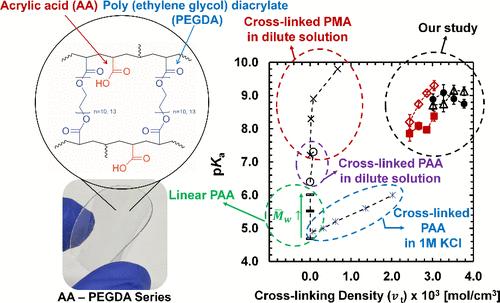当前位置:
X-MOL 学术
›
Macromolecules
›
论文详情
Our official English website, www.x-mol.net, welcomes your
feedback! (Note: you will need to create a separate account there.)
Determination of Carboxyl Dissociation Degree and pKa in Weak Polyelectrolyte Membranes via POT Titration and FTIR Analysis for Clean Technologies in Sustainability
Macromolecules ( IF 5.1 ) Pub Date : 2024-11-08 , DOI: 10.1021/acs.macromol.4c02139 Yongha Kim, Taekwon Kim, Dae Eun Kang, Jack S. Szymanski, Riley B. Kracaw, Andrew J. Lukaszewski, Kyle M. Tierney, Michael A. Shaqfeh, Charleen M. Rahman, Hee Jeung Oh
Macromolecules ( IF 5.1 ) Pub Date : 2024-11-08 , DOI: 10.1021/acs.macromol.4c02139 Yongha Kim, Taekwon Kim, Dae Eun Kang, Jack S. Szymanski, Riley B. Kracaw, Andrew J. Lukaszewski, Kyle M. Tierney, Michael A. Shaqfeh, Charleen M. Rahman, Hee Jeung Oh

|
Charged polymer membranes play a crucial role in clean technologies for sustainability. Previously, we have designed a series of weak polyelectrolyte membranes, i.e., acrylic acid–poly(ethylene glycol) diacrylate (AA-PEGDA) networks with a wide ion-exchange capacity range (IEC: 0–4 mequiv/g) and limited water swelling. An acrylic acid (AA) monomer was used to control the amount of dissociated charged (COO–) groups versus pH. To systematically quantify the dissociated charged (COO–) group content in the polymers, we reported the degree of ionization (α) and negative logarithm of acid dissociation constant (pKa) of AA-PEGDA series at varied external pH via conventional potentiometric titration (POT titration) and widely available ATR-FTIR analysis. Contact angle measurement was also used to record the surface hydrophilicity vs pH to support the analysis. Overall, the degree of ionization (α) vs pH trends via three different methods well-align to each other, indicating that three methods which (1) measure pH changes in a solution phase (POT titration), (2) directly probe dissociated COO– groups in a polymer phase (ATR-FTIR) and (3) record surface hydrophilicity (contact angle) reasonably describe the molecular-level, physical picture of dissociation process in the polymers. For all compositions, as external pH increases (pH = 5–12), the degree of ionization (α) also increases between 0 and 1, following the modified Henderson–Hasselbalch equation. As the maximum ion-exchange capacity (mIEC) increases (AA content increases and PEGDA cross-linker content decreases), the decreased cross-linking density and simultaneously increased water content dominantly reduce the overall electrostatic repulsion, showing decreased pKa. Our system shows higher cross-linking density and was tested in dilute conditions, showing increased pKa values compared with those of other polymers in the literature. To the best of our knowledge, this is the first time the charged group concentration (mIEC) and cross-linking density have been systematically changed to record the pKa trend in thin film forms using a single polymer network system. Our AA-PEGDA series can provide a platform to advance our understanding of the dissociation process in weak polyelectrolyte polymers.
中文翻译:

通过 POT 滴定和 FTIR 分析测定弱聚电解质膜中的羧基解离度和 pKa,用于可持续性清洁技术
带电聚合物膜在实现可持续发展的清洁技术中发挥着至关重要的作用。以前,我们设计了一系列弱聚电解质膜,即丙烯酸-聚乙二醇二丙烯酸酯 (AA-PEGDA) 网络,具有较宽的离子交换容量范围 (IEC:0-4 mequiv/g) 和有限的水溶胀。丙烯酸 (AA) 单体用于控制解离带电 (COO–) 基团的量与 pH 值的关系。为了系统地定量聚合物中的解离带电 (COO–) 基团含量,我们通过常规电位滴定法(POT 滴定)和广泛使用的 ATR-FTIR 分析报告了 AA-PEGDA 系列在不同外部 pH 下的电离度(α) 和酸解离常数 (PKA) 的负对数。接触角测量还用于记录表面亲水性与 pH 值的关系,以支持分析。总体而言,通过三种不同方法的电离度 (α) 与 pH 值趋势非常吻合,这表明三种方法 (1) 测量液相中的 pH 值变化(POT 滴定),(2) 直接探测聚合物相中解离的 COO– 基团 (ATR-FTIR) 和 (3) 记录表面亲水性(接触角)合理地描述了聚合物中解离过程的分子水平物理图像。对于所有成分,随着外部 pH 值的增加 (pH = 5–12),电离度 (α) 也会在 0 到 1 之间增加,遵循修正的 Henderson-Hasselbalch 方程。 随着最大离子交换容量 (mIEC) 的增加(AA 含量增加,PEGDA 交联剂含量降低),交联密度降低和同时水分含量增加主要降低整体静电排斥力,显示 pKa 降低。我们的系统显示出更高的交联密度,并在稀释条件下进行了测试,与文献中的其他聚合物相比,显示 pKa 值增加。据我们所知,这是第一次系统地改变带电基团浓度 (mIEC) 和交联密度,以使用单一聚合物网络系统以薄膜形式记录 pKa 趋势。我们的 AA-PEGDA 系列可以提供一个平台,以促进我们对弱电解质聚合物中解离过程的理解。
更新日期:2024-11-09
中文翻译:

通过 POT 滴定和 FTIR 分析测定弱聚电解质膜中的羧基解离度和 pKa,用于可持续性清洁技术
带电聚合物膜在实现可持续发展的清洁技术中发挥着至关重要的作用。以前,我们设计了一系列弱聚电解质膜,即丙烯酸-聚乙二醇二丙烯酸酯 (AA-PEGDA) 网络,具有较宽的离子交换容量范围 (IEC:0-4 mequiv/g) 和有限的水溶胀。丙烯酸 (AA) 单体用于控制解离带电 (COO–) 基团的量与 pH 值的关系。为了系统地定量聚合物中的解离带电 (COO–) 基团含量,我们通过常规电位滴定法(POT 滴定)和广泛使用的 ATR-FTIR 分析报告了 AA-PEGDA 系列在不同外部 pH 下的电离度(α) 和酸解离常数 (PKA) 的负对数。接触角测量还用于记录表面亲水性与 pH 值的关系,以支持分析。总体而言,通过三种不同方法的电离度 (α) 与 pH 值趋势非常吻合,这表明三种方法 (1) 测量液相中的 pH 值变化(POT 滴定),(2) 直接探测聚合物相中解离的 COO– 基团 (ATR-FTIR) 和 (3) 记录表面亲水性(接触角)合理地描述了聚合物中解离过程的分子水平物理图像。对于所有成分,随着外部 pH 值的增加 (pH = 5–12),电离度 (α) 也会在 0 到 1 之间增加,遵循修正的 Henderson-Hasselbalch 方程。 随着最大离子交换容量 (mIEC) 的增加(AA 含量增加,PEGDA 交联剂含量降低),交联密度降低和同时水分含量增加主要降低整体静电排斥力,显示 pKa 降低。我们的系统显示出更高的交联密度,并在稀释条件下进行了测试,与文献中的其他聚合物相比,显示 pKa 值增加。据我们所知,这是第一次系统地改变带电基团浓度 (mIEC) 和交联密度,以使用单一聚合物网络系统以薄膜形式记录 pKa 趋势。我们的 AA-PEGDA 系列可以提供一个平台,以促进我们对弱电解质聚合物中解离过程的理解。


















































 京公网安备 11010802027423号
京公网安备 11010802027423号